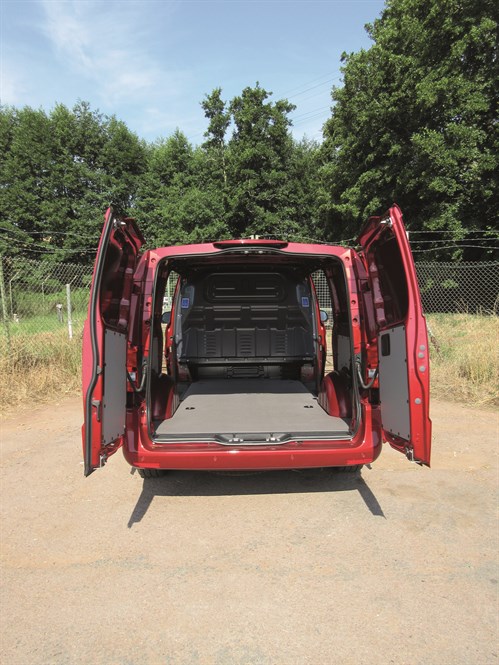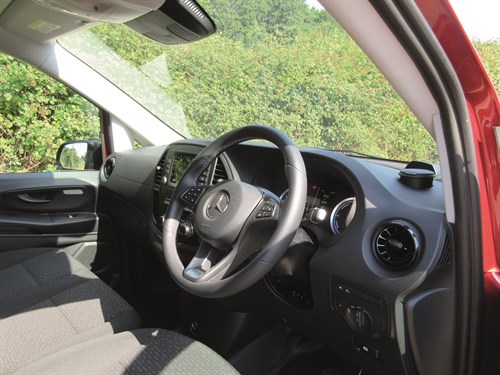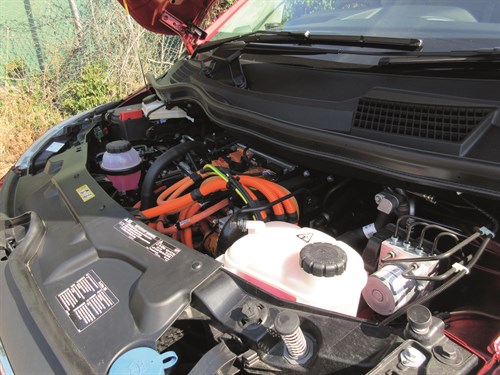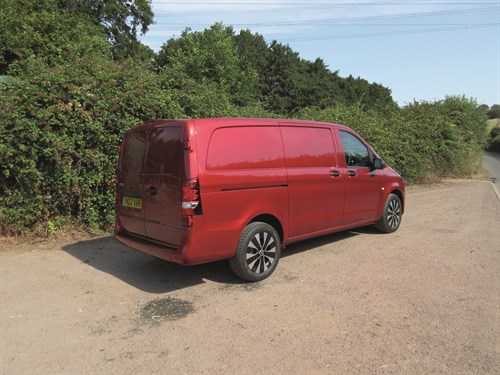While some businesses will undoubtedly cling doggedly to their diesel vans until they fall apart, we all have to face facts. Zero-emission electric light commercials represent the future and we’re going to have to get used to the idea; like it or not.
Not surprisingly, prospective operators worry about their drawbacks. They include a limited range between recharges, the length of time it takes for a battery pack to achieve a 100% charge, eye-watering front-end prices and a patchy publicly-accessible charging infrastructure.
Too few charging bays in car parks and other locations are big enough to accommodate anything other than a light van. Try to get an electric 3.5-tonner into one and get it plugged in and you may struggle.
Things are steadily improving however. While the old Mercedes-Benz eVito could barely cover 90 miles before its battery needed replenishing, its successor is good for up to 162 miles, says the manufacturer, according to WLTP (Worldwide Harmonised
Light Vehicle Test Procedure) figures. That is of course nowhere near what a diesel van with a full tank of fuel can achieve, but it is a definite step in the right direction.
Find yourself a rapid 80kW DC charging point and you can boost your battery from 10% to 80% of its maximum capacity in just 35 minutes, says Mercedes. Overnight charging from 0% to 100% using an 11kW AC wall box Type 2 charger takes 6.5 hours, it adds.
Front-end prices remain woefully-high though and electricity is notoriously not quite as cheap as it once was.
Furthermore, if you do not happen to have a domestic wallbox and you have no choice but to plug your eVito into a standard household socket then a full recharge will take around 20 hours, says Mercedes. We can confirm that figure is correct from personal experience.
Available with two different wheelbases – L2 or L3 – and a single roof height, eVito comes with a choice of two trim levels; Progressive, or the newly-introduced and more-upmarket Premium. Both models boast the same electric motor and power train.
We whispered along in an L2 Premium and tried to avoid startling pedestrians and cyclists. An acoustic warning device, which triggers at below 19mph helped ensure we didn’t do so.

Load bay
Rear entry to the front-wheel drive L2 eVito’s 6.0m3 load bay (L3 offers 6.6m3) is through twin doors that can be swung through 90°, then through a full 180º if required; an easy exercise. They are complemented by a sliding door on each side of the cargo body.
Eight load lashing rings are fitted, as is a hefty full-height steel bulkhead designed to protect the occupants of the cab if unsecured items hurtle forwards under heavy braking.
The bulkhead is shaped in such a way that it slightly restricts loading through the side door apertures. On the positive side, however, it gives access to the space under the front seats so that long items such as planks and ladders can be carried more easily.
By doing so it increases load bed length by 370mm to 2,831mm.
The load bed was protected from scratches and scrapes by a tailored cover and there was some protection for the sides. The cargo area needs properly timbering out however, to prevent damage during loading and unloading.
Bear in mind that while some manufacturers allow electric vans to pull a trailer, that is not the case with eVito. Towing is not permitted – a drawback for some businesses.

Interior and equipment
The level of equipment you enjoy with a Premium eEvito goes some way towards justifying its price tag.
For your money you get air-conditioning, a reversing camera, parking sensors, heated seats (optional for the passenger perches), cruise control, two USB sockets and a 12V power point. Electric windows and electrically-adjustable exterior mirrors are included in the deal too – the latter fold in and out automatically – as are front fog lights.
A 7in touchscreen controls many of the in-cab functions, including the optional Audio 40 satellite navigation package, and we would prefer to see a much bigger one.
A DAB radio and smartphone integration with Apple CarPlay and Android Auto are included in the deal, as is Bluetooth connectivity plus a three-year subscription to the Mercedes me app. It provides connectivity to a variety of digital services including Navigation with Electronic Intelligence, which allows routes to be plotted with reference to public charging points.
The app also allows users to programme the heating or cooling of eVito’s cab interior while the battery is charging, helping to maximise the available range and ensuring that the driver will be comfortable from the moment of departure.
The driver’s seat and the leather-trimmed steering wheel are both height-adjustable, the seat back comes with lumbar adjustment and the angle of the seat cushion can be altered. The cab is a three-seater, but whoever sits on the middle seat will have to put up with restricted legroom thanks to the way in which a plastic moulding bulges out from the fascia.
Turning to in-cab storage facilities, each door has two bins, one of which features a moulding that can hold a flask of tea or a large bottle of water. Present too are a roomy, lidded, and lockable glove-box plus three shelves of varying sizes that sit on top of the dashboard.
One of the two cup holders mounted on the dashboard boasts a removable miniature waste bin that can slot into either of them.
Mercedes has, for some time, made safety a priority in its light commercials and the latest eVito is no exception, with more systems installed than was the case with the previous model.
They include Active Brake Assist with pedestrian recognition, designed to stop you running into the back of the vehicle in front or mowing down wayward jaywalkers.
You also benefit from Attention Assist, an on-board nanny which prompts you to stop and grab a cup of coffee if you seem to be drowsy. Fitted too is Cruise Control with an adaptive speed limiter.
As a consequence eVito was awarded a Gold safety rating by independent crash testing body Euro NCAP in 2021 says Mercedes. Driver and passenger airbags are fitted while other on-board safety devices include ABS, ESP and Hill Start Assist.
Crosswind Assist should ensure you are not wafted into the adjacent lane on a dual carriageway or motorway if eVito is suddenly struck by a gale. Sensors ensure the windscreen wipers are triggered if it starts to rain.
Optional safety devices on our demonstrator included Lane Keeping Assist and an LED Intelligent Light System, which, among other things, automatically adapts the intensity of the van’s lights in line with weather, speed and the prevailing light conditions. Other features include a cornering function which automatically pivots the headlamps.
Disc brakes – ventilated at the front – deliver stopping power to all four wheels.
Rack-and-pinion steering is installed. Turning to the suspension, MacPherson struts are provided at the front while a rigid axle with parabolic springs helps to support the rear.
Our test van’s attractive-looking 17in alloy wheels were shod with Dunlop Econodrive 225/55 R17C tyres. They are protected by pressure monitoring.

Powertrain
A 66kWh lithium-ion battery powers a front-mounted asynchronous electric motor delivering peak power of 85kW and a steady output of 70kW, with 300Nm of torque on tap.
The battery charging point is under a flap on the van’s nearside front wing.
Driving
Before you pull away from the kerb in an eVito you need to decide which level of performance you need; E for Efficiency, E+ for even greater economy or C for Comfort.
The last designation offers what one might describe as mainstream on-highway performance while the other two are designed to maximise range. You make your selection using the Dynamic button on the dashboard.
We settled on E most of the time, occasionally opting for C. The E setting limits the van’s performance but not to the extent that it seriously restricts progress, at least when you are lightly-laden and on reasonably flat terrain.
E+ imposes strict limits however and slows you down noticeably, especially if you have some weight on board.
Your next task is to determine the level of regeneration you require; in other words, the extent to which kinetic energy will be pumped into the battery when you release the accelerator pedal and allow the van to coast. The steep hills we needed to tackle in Gloucestershire’s Forest of Dean prompted us to choose the maximum available using paddles on either side of the steering column.
An automatic recuperation system is present which chooses the best level for you if you cannot decide yourself.
Another way of maintaining eVito’s range is to have its maximum speed governed to 50mph. Happily our test van did not have this option throttling it, and was instead restricted to 75mph; the standard arrangement.
We were driving eVito in blazing hot summer weather, and as a consequence had the highly-effective air-conditioning running full blast on several occasions. The minute we switched it on the projected range shown on the dashboard display fell from 154 to 137 miles as a result of the power it draws.
We were nevertheless able to accomplish a lightly-laden 97-mile round trip from just south of Ross-on-Wye in Herefordshire to Bromfield in Shropshire, and get back to home base with 54 miles to spare.
The battery Vito rides well and handles well, although the steering could stand to be tightened up a little to deliver better feedback as you swing through bends. There is of course no engine noise, but this results in tyre and wind noise becoming much more noticeable; so the cab interior is not as quiet as one might expect.
The absence of an engine is matched by the absence of a conventional gearbox.
All you need to do is use a stalk on the steering wheel to select Reverse, Neutral or Drive. A button on the end of the stalk gives you a P for Park setting.
As well as giving you your projected range, the aforementioned dashboard display tells you how much charge is left in the battery and how much power you are using. You tend to try to drive with the tell-tale needle on the dial kept in either the Economy or the Charge sector; hopefully without taking your eyes too far off the road.
We’ve said it before and we’ll say it again, despite the fact that Mercedes takes not one whit of notice; we cannot for the life of us understand why the Three Pointed Star continues to equip Vito with such a peculiar parking brake. You press a small pedal next to the clutch pedal to set it, then pull a lever at the bottom of the dashboard to release it to the accompaniment of a loud bang.
Mercedes should really consider installing an electric parking brake instead. Either that, or fit a conventional handbrake lever.

Operating
Mercedes provides a three-year/unlimited-mileage warranty plus an eight-year/100,000-mile warranty for the battery. Should there be a problem then help is at hand courtesy of MobiloVan, the Three Pointed Star’s free 24/7 roadside assistance scheme.
A 12-year anti-perforation corrosion warranty is provided as well.
Governed by time rather than mileage, servicing is annual. The aforementioned me app monitors the health of critical parts, and delivers real-time updates on any maintenance requirements that can be relayed remotely to the operator’s local Mercedes dealer.
Hopefully thieves will be frustrated by the standard deadlocks and scared away by the standard Thatcham Category 1 alarm.
Our Vito was finished in attractive-looking red metallic paint – an option – and it seemed a pity that there were no side rubbing strips to protect it against minor damage. Good to see a full-size spare wheel provided though.
Bear in mind that at the time of writing eVito was eligible for a government grant from the Office of Zero Emission Vehicles of up to £5,000 towards the purchase price.
Mercedes-Benz eVito Premium L2
Price (ex. VAT) £46,900
Price range (ex. VAT) £43,600–£46,900
Gross payload 749kg
Load length 2,461mm
Load width (min/max) 1,270mm/1,685mm
Load bay height 1,391mm
Load volume 6.0m3
Loading height 558mm
Rear door aperture 1,333mm x 1,270mm
Side door aperture 990mm x 1,346mm
Gross vehicle weight 3,200kg
Braked trailer towing weight N/A
Residual value 28.2%*
Cost per mile 70.6p
Engine size/power 85kW electric motor
Torque 300Nm
Gearbox 1sp
Warranty 3yrs/unltd mileage
Service intervals annual
Insurance group 39E
Price as tested £49,835
* after 48 months/20,000 miles p.a – source – KWIKcarcost
Options
Audio 40 navigation £400
Illuminated vanity mirrors for sun visors £100
Heated seat for co-driver £210
Lane Keeping Assist £455
LED front intelligent light system £1,770
Rivals
Ford E-Transit Custom
Price (ex VAT) TBA
Load volume 5.8-9.0m3
Gross payload 1,100kg
Electric motor 101kW, 162kW
Verdict: Normally we would not cite a model that is not yet available as a rival to an existing vehicle, but in this case it is justified given Ford Transit Custom’s staggering success in the UK market. E-Transit Custom won’t be on sale for another 12 months, but with a claimed range of up to 236 miles, it could be well worth the wait.
Vauxhall Vivaro-e
Price (ex VAT) £39,731-£43,381
Load volume 5.3-6.1m3
Gross payload 1,000-1,226kg
Electric motor 100kW
Verdict: A highly-successful model with a respectable range between recharges, Vivaro-e demonstrates that an electric van is a viable choice for a wide range of businesses. Bear in mind that Vauxhall is part of the Stellantis group, and that the same model is available with Citroen, Peugeot and Fiat Professional badges, and as a Toyota too thanks to a joint-venture agreement Stellantis has with the Japanese manufacturer.
Volkswagen ID. Buzz Cargo
Price (ex VAT) £38,125-£42,375
Load volume 3.9m3
Gross payload 650kg
Electric motor 152kW
Verdict: ID. Buzz Cargo is smaller than eVito, but looks set to have a big impact. We’ve driven it, and can report that when it comes to performance, ride quality and agility, VW’s newcomer is utterly outstanding. Claimed range is a creditable 258 miles, but while the cab is roomy and comfortable, the infotainment system is woefully confusing.
The Final Verdict
Design 8/10 – Plenty of clever features installed to maximise range, and they’re easy to use
Cabin 6/10 – Well-equipped, centre seating position constricted, plus the peculiar parking brake
Ride 7/10 – Suspension copes pretty well with Britain’s poor highway surfaces
Refinement 7/10 – Amazing build quality, but absence of diesel decibels highlight other noise sources
Load area 8/10 – Access from both sides and good rear, front-wheel drive means low loading height
Handling/performance 8/10 – Former is dependable though steering could be tighter. Latter depends on setting
Engine/transmission 8/10 – Electric motor and the single-speed transmission deliver the goods with little fuss
Standard equipment 9/10 – Premium trim with plenty of goodies, on-board safety focus should be praised
Operating costs 8/10 – Long battery warranty, good servicing on what should be a low-mileage vehicle
What Van? subjective rating 7/10 – Worthy of consideration but Vivaro-e and electric Transit Custom may have the edge
Overall rating = 76/100





